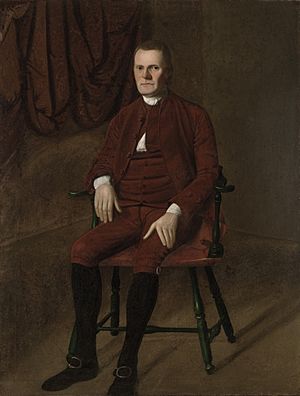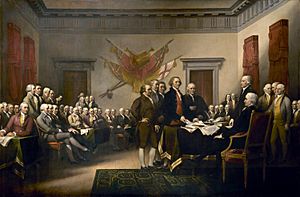Roger Sherman facts for kids
Quick facts for kids
Roger Sherman
|
|
|---|---|
 |
|
| United States Senator from Connecticut |
|
| In office June 13, 1791 – July 23, 1793 |
|
| Preceded by | William S. Johnson |
| Succeeded by | Stephen M. Mitchell |
| Member of the U.S. House of Representatives from Connecticut's at-large district |
|
| In office March 4, 1789 – March 3, 1791 |
|
| Preceded by | None |
| Succeeded by | Amasa Learned |
| Member of the Confederation Congress from Connecticut | |
| In office 1784–1784 |
|
| Delegate to the Continental Congress from Connecticut | |
| In office 1774–1781 |
|
| 1st Mayor of New Haven, Connecticut | |
| In office 1784–1793 |
|
| Preceded by | Position established |
| Succeeded by | Samuel Bishop |
| Personal details | |
| Born | April 19, 1721 Newton, Province of Massachusetts, British America |
| Died | July 23, 1793 (aged 72) New Haven, Connecticut, U.S. |
| Resting place | Grove Street Cemetery New Haven, Connecticut, U.S. |
| Spouses | Elizabeth Hartwell Rebecca Minot Prescott |
| Profession | Politician and lawyer |
| Signature | |
Roger Sherman (born April 19, 1721 – died July 23, 1793) was an important American statesman and lawyer. He is known as one of the Founding Fathers of the United States. He holds a special place in history because he is the only person to sign four major founding documents of the United States.
These documents include the Continental Association, the Declaration of Independence, the Articles of Confederation, and the U.S. Constitution. He also signed the 1774 Petition to the King.
Sherman was born in Newton, Massachusetts. He became a lawyer in Litchfield County, Connecticut, even though he didn't have much formal schooling. He served in the Connecticut House of Representatives. Later, he was a judge on the Superior Court of Connecticut from 1766 to 1789.
He represented Connecticut at the Continental Congress. He was also part of the Committee of Five that helped write the Declaration of Independence. Sherman was a delegate at the 1787 Philadelphia Convention, where the U.S. Constitution was created. He was the second oldest delegate there, after Benjamin Franklin.
Sherman supported giving the new federal government power to collect money and manage trade. He was a key figure who helped create the Connecticut Compromise. This compromise helped settle disagreements between larger and smaller states. After the Constitution was approved, Sherman represented Connecticut in the United States House of Representatives and then in the United States Senate until he died.
Contents
Roger Sherman's Early Life and Family
Roger Sherman was born into a farming family in Newton, Massachusetts. His parents were William and Mehetabel Sherman. When Roger was two, his family moved to what is now Stoughton, Massachusetts. This town was about 17 miles (27 km) southeast of Newton.
Sherman's formal education was limited to grammar school. He learned a lot from his father's library. A Harvard-educated minister, Rev. Samuel Dunbar, also helped him learn. His first job was as a shoemaker.
In 1743, Roger's father passed away. Sherman then moved with his mother and siblings to New Milford, Connecticut. There, he and his brother William opened the town's first store. He quickly became involved in local government and religious matters. He soon became one of the town's most important citizens and its town clerk. In 1745, he became the county surveyor for New Haven County. He also started doing calculations for almanacs in 1759.
Sherman married twice and had fifteen children. Thirteen of his children lived to be adults. He first married Elizabeth Hartwell in 1749. After she died in 1760, he married Rebecca Prescott in 1763. They had eight children together.
Roger Sherman's Political Journey
Starting a Career in Politics
Even though Roger Sherman didn't go to college, a local lawyer encouraged him to study law. He passed the bar exam in Litchfield, Connecticut, in 1754. He then wrote a paper called "A Caveat Against Injustice."
From 1755 to 1758, and again from 1760 to 1761, he represented New Milford in the Connecticut House of Representatives. In 1775, Sherman became a justice of the peace. He was also made a judge of the court of common pleas in 1765.
In 1766, Sherman was elected to the Governor's Council of the Connecticut General Assembly. He served there until 1785. He also worked as a Justice of the Superior Court of Connecticut from 1766 to 1789.
Sherman was also the treasurer for Yale College. He received an honorary Master of Arts degree from Yale. He taught Christian religion for many years. In 1784, Sherman was elected mayor of New Haven. He held this position until his death.
Serving in Congress

As a member of the First Continental Congress, Sherman signed the Continental Association. This agreement created an economic boycott against British trade. In the Second Continental Congress, Sherman was chosen for the Committee of Five. This committee was tasked with writing the Declaration of Independence.
Sherman was also on the committee of 13. This group was responsible for creating a first draft of a constitution for the new nation. During discussions, Sherman suggested a two-house national legislature. In this plan, states would have equal representation. The committee of 13 did not accept his idea at that time. They chose a one-house legislature, which became the Articles of Confederation.
As a member of the Confederation Congress, Sherman signed the Treaty of Paris. This treaty officially ended the Revolutionary War.
The Constitutional Convention
Sherman went to the 1787 Constitutional Convention not planning to create a brand new constitution. He thought the convention should just change the existing government. He believed that amending the Articles of Confederation was best for the people. He felt this was the most likely way people would accept changes.
Sherman thought the national government mainly needed ways to raise money and manage trade. His ideas were shaped by Connecticut's independent nature. Connecticut traded with the West Indies using its own ports. It didn't rely much on other states.
Sherman also believed that ordinary people might not have enough wisdom to govern themselves. He didn't want any part of the federal government to be directly elected by the people. His personal beliefs and Puritan views also influenced him.
Sherman was against slavery. He used this issue to help make deals and form alliances. He saw that slavery could threaten the success of the Constitutional Convention. So, he helped create compromises that benefited slave states. This helped him gain allies from the Carolinas.
Sherman is also known for his opposition to paper money. He helped write Article I, Section 10 of the U.S. Constitution. He later disagreed with James Madison about the Bill of Rights. Sherman believed these amendments would lessen the power of the states.
He also had little interest in creating a strong executive branch. He thought the executive branch was "nothing more than an institution for carrying the will of the Legislature into effect."
How States Would Be Represented
During the convention, two main ideas for the legislative branch came up. One idea, from the Virginia Plan, was a two-house legislature. In this plan, both houses would have representation based on the state's population. The second idea, supported by the New Jersey Plan, was to keep a one-house legislature. This house would have equal representation for all states. Sherman helped write the New Jersey Plan.
Sherman didn't see a need for two houses at first. He defended the one-house legislature of the Articles of Confederation. He said that larger states had not suffered from smaller states having equal votes. Sherman, Elbridge Gerry, and others believed that state officials should elect the national government. They thought ordinary citizens should not directly elect federal officials. Sherman worried about allowing common citizens to participate too much in national government. He said people "should have as little to do as may be about the Government."
While Sherman strongly supported a one-house legislature, he realized it wouldn't be accepted by the larger states. With help from Oliver Ellsworth, Sherman repeatedly suggested a two-house compromise. In this plan, one house would have representation based on population. The other house would have equal representation for each state.
Many experts see Sherman as a crucial delegate at the Convention. This is because of his role in solving the debate over representation. He consistently pushed for the interests of the less populated states. When delegates couldn't agree, Sherman helped send the issue to a special committee. This committee, called the Grand Committee, was sympathetic to the smaller states' views. Sherman was a member of this committee.
The plan that came from the Grand Committee was first suggested by Sherman. It became known as the Connecticut Compromise. This plan was designed to satisfy both large and small states. In the House of Representatives (the lower house), people would be represented based on population. In the Senate (the upper house), each state would have two senators, no matter its size. Sherman supported allowing each state legislature to elect its own senators. For the House, Sherman first suggested that voting power should be based on the "numbers of free inhabitants" in each state.
Later Political Work
Sherman was elected as a United States Representative in the First Congress. Then, he was elected to the Senate in the Second and Third Congress. He served there until his death in 1793.
In 1790, Sherman and Richard Law were asked to update Connecticut's old laws. They successfully completed this task. Throughout his life, Sherman was a big supporter of Yale College. He served as the university's treasurer for many years. He also helped fund the building of a college chapel.
Sherman opposed the appointment of Gouverneur Morris as minister to France. He thought Morris was too "irreligious."
Roger Sherman's Death and Burial
Roger Sherman passed away in his sleep on July 23, 1793. He had been sick for two months with what was thought to be typhoid fever. A newspaper, the Gazette of the United States, reported that his doctor thought his illness was in his liver.
He was first buried in New Haven Green. In 1821, when that cemetery was moved, his remains were moved to the Grove Street Cemetery. Jonathan Edwards Jr. gave a funeral speech for Sherman on July 25, 1793. He praised Sherman's contributions to his friends, family, town, and country. He also noted Sherman's strong faith and excellent studies.
Roger Sherman's Legacy

Roger Sherman is very important in United States history. He is the only person to sign all four major founding documents: the Articles of Association, the Declaration of Independence, the Articles of Confederation, and the U.S. Constitution. Robert Morris signed three of them, missing the Articles of Association. John Dickinson also signed three, but he chose not to sign the Declaration of Independence.
Sherman was one of the most influential members of the Constitutional Convention. He isn't as famous as some others because he was a "terse, ineloquent speaker." He also didn't keep a personal record of his experiences, unlike other important figures.
At 66 years old, Sherman was the second oldest member at the convention. Only Benjamin Franklin, who was 81, was older. Yet, Sherman was a strong opponent of James Madison and the larger states. Sherman was also one of the most active members of the Convention. He made or seconded motions 160 times, just a bit less than Madison's 177 times.
The town of Sherman, Connecticut, was named after Roger Sherman. A sculpture of the Committee of Five, including Sherman, is on the pediment of the Jefferson Memorial in Washington, D.C.
See also
 In Spanish: Roger Sherman para niños
In Spanish: Roger Sherman para niños
- List of United States Congress members who died in office (1790–1899)
- Memorial to the 56 Signers of the Declaration of Independence


